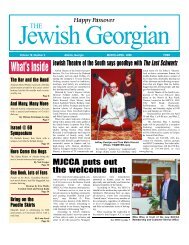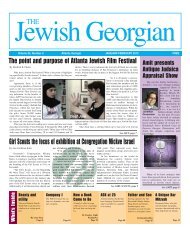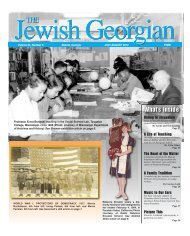JGA July-August 09 - The Jewish Georgian
JGA July-August 09 - The Jewish Georgian
JGA July-August 09 - The Jewish Georgian
Create successful ePaper yourself
Turn your PDF publications into a flip-book with our unique Google optimized e-Paper software.
<strong>July</strong>-<strong>August</strong> 20<strong>09</strong> THE JEWISH GEORGIAN Page 29<br />
Temple’s iSeder sparks discussion<br />
about religion and technology<br />
As humans, our day-to-day lives are in<br />
perpetual flux. This is especially true for<br />
those living in nations built on progress,<br />
such as the United States. Specifically, our<br />
always-increasing contact with technology<br />
has transformed who we are as a people, our<br />
methods of communication, and how we<br />
send and retrieve information on a by-thesecond<br />
basis.<br />
While the advent of technology has<br />
certainly been responsible for countless<br />
social, medical, and scientific advancements,<br />
all of the beneficial kind, it is an<br />
aspect of life that has often, and intentionally,<br />
been removed from traditional religious<br />
practice.<br />
In Judaism in particular, there has forever<br />
been a conscious effort to separate<br />
technology and prayer, an unquestioned<br />
sense that interaction with technology<br />
somehow de-spiritualizes practices of piety.<br />
Torah scrolls and mezuzot must be written<br />
by the hands of expert scribes, the Hebrew<br />
Bible commands that no Temple be built<br />
with iron tools, most traditional forms of<br />
technology are put to rest once a week for<br />
Shabbat—the holiest day of the <strong>Jewish</strong><br />
week—and, to this day, Orthodox Jews seek<br />
out homes nearest their synagogue, so as to<br />
avoid driving there before sessions of<br />
prayer.<br />
Is this traditionally disharmonious relationship<br />
between Judaism and technology<br />
inherent or fundamental to the nature of<br />
religion? Or, rather, is it a condition that<br />
was developed, learned, and integrated over<br />
time, a superficial notion that is challenged<br />
more and more every day, as technology<br />
continues to creep into nearly every aspect<br />
of our lives?<br />
As this conflict rages on, <strong>The</strong> Temple,<br />
Atlanta’s largest and oldest Reform synagogue,<br />
used Passover 20<strong>09</strong> to add a new<br />
chapter to the ongoing discussion, taking a<br />
revolutionary step in not just allowing and<br />
accepting technology, but actually attempting<br />
to utilize it as a productive tool in<br />
<strong>Jewish</strong> tradition and ceremony.<br />
<strong>The</strong> idea, sparked by Rabbi Frederick<br />
Reeves—one of <strong>The</strong> Temple’s four clergy<br />
members—was to incorporate today’s most<br />
prevalent and popular forms<br />
of technology into the second<br />
night of Passover, an<br />
experiment Rabbi Reeves<br />
coined the iSeder. <strong>The</strong> rabbi<br />
set up a computer at each of<br />
four 10-person tables and a<br />
larger projector on which<br />
those present could follow<br />
the service. Each computer<br />
was connected to a wireless<br />
Internet network, while<br />
BlackBerrys and iPhones<br />
were welcomed as well.<br />
Over the course of the night,<br />
a PowerPoint presentation<br />
on the 15 steps of the Haggadah was given,<br />
various Internet polls on the ten plagues<br />
Rabbi Frederick Reeves<br />
BY<br />
Scott<br />
Janovitz<br />
were taken, YouTube and Facebook were<br />
scoured, and a virtual Internet search for the<br />
afikomen was conducted.<br />
But if technology has always been considered<br />
a roadblock to spiritualism, and<br />
Judaism is about achieving just that, why<br />
would a rabbi intentionally integrate the<br />
two on one of the holiest days of the <strong>Jewish</strong><br />
year?<br />
“<strong>The</strong> intent was to try and see how we<br />
could use new technology to engage people,”<br />
Reeves explained. “Partially, we did it<br />
because the Internet is fun and partially to<br />
reach the 20s-30s group; that group is not<br />
interested in the regular kinds of offerings<br />
that synagogues have, and so we thought<br />
this would be cool and get their attention, so<br />
that they would come and have a <strong>Jewish</strong><br />
experience.”<br />
Throughout the iSeder, those in attendance<br />
were encouraged to play active roles,<br />
as they were texted specific blessings via<br />
their phones when it was their turn to read.<br />
In this way, then, Reeves used technology<br />
as a sort of rallying point, as a method of<br />
attracting and involving Jews, rather than as<br />
barrier to <strong>Jewish</strong> practice.<br />
“We have in our mindset the idea that<br />
somehow technology and spirituality are<br />
separate. I think that part of that has to do<br />
with the fact that, after the Industrial<br />
Revolution and the dawn of the Information<br />
Age, there was a sense of depersonalization<br />
that came with the advent of mass technology,”<br />
explains Reeves. “<strong>The</strong> idea is that<br />
things are no longer individualized or personalized,<br />
and one of the big things that we<br />
try and do through the synagogue is make<br />
connections person-to-person. <strong>The</strong>re’s a<br />
general sense that technology puts a filter or<br />
a wall between people, and technology is<br />
only going to be successful in religious settings<br />
if it’s used to break down those walls<br />
and bring people together.”<br />
Through his carefully calculated<br />
attempt to integrate<br />
technology into traditional<br />
<strong>Jewish</strong> ceremony, Reeves<br />
has demonstrated a clear<br />
trust in this relationship,<br />
refusing to accept the two as<br />
inherently conflicting entities.<br />
With the future in mind,<br />
however, questioning the<br />
degree of compatibility<br />
between religion and technology<br />
may no longer be the<br />
most relevant concern.<br />
Simply put, technology will<br />
play an increasingly greater role in our liv<br />
See iSEDER, page 37
















